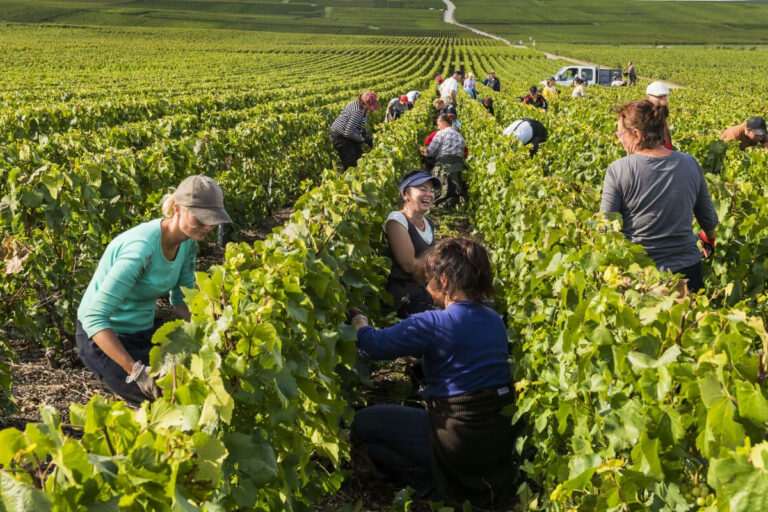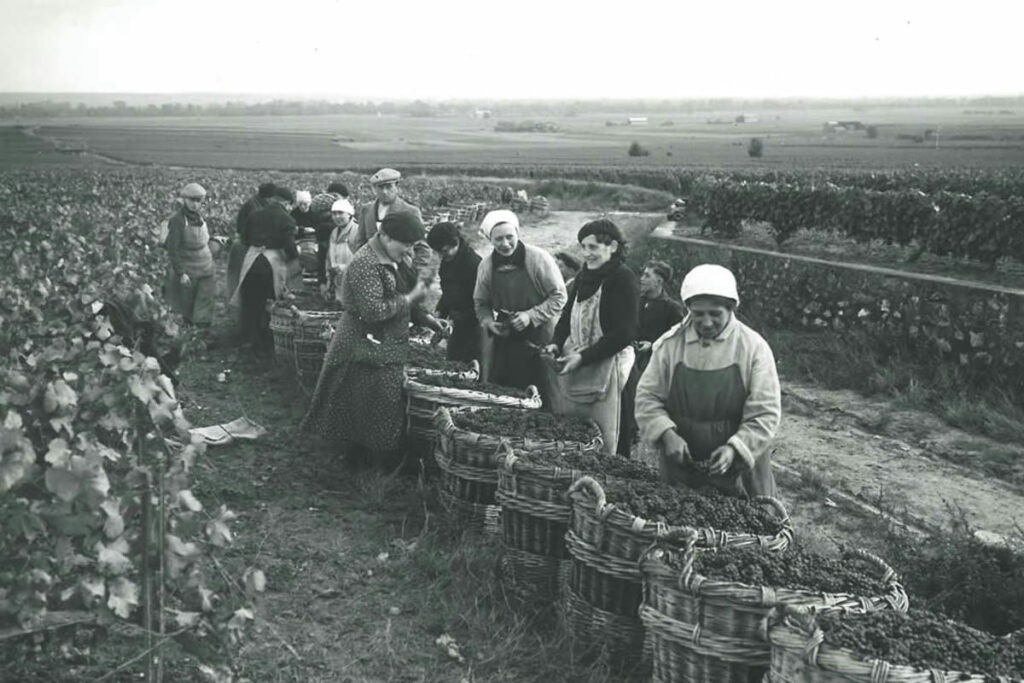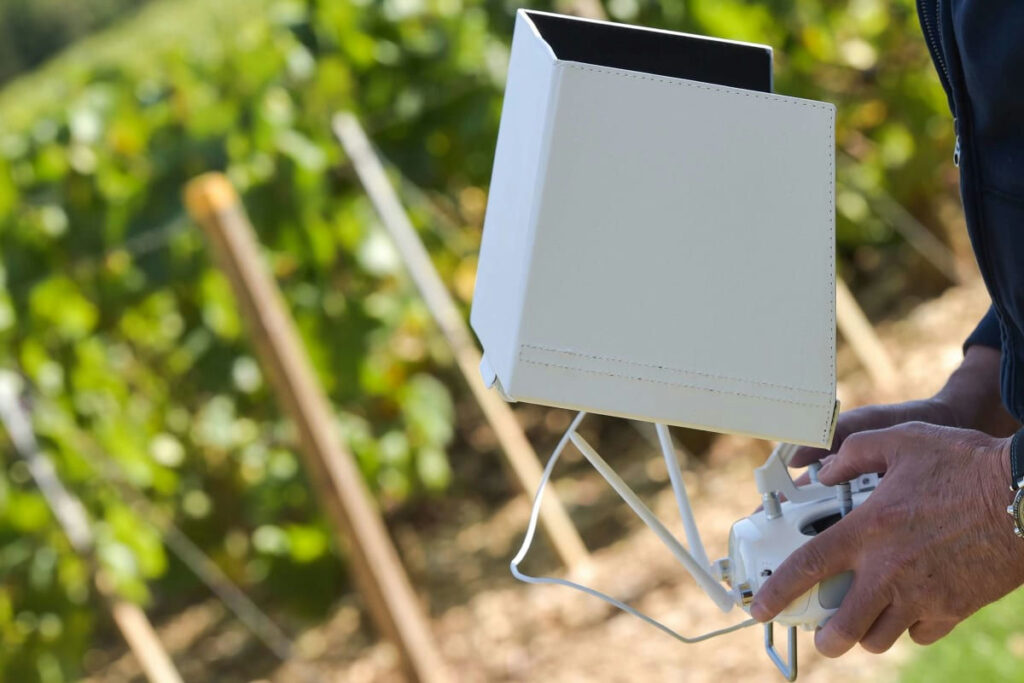
The history of the harvest in Champagne is both a story of passion and tradition and a series of technical evolutions. The Champagne region, renowned worldwide for its sparkling wine, saw its vineyards planted as early as the Gallo-Roman period. The earliest manuscripts relating to the harvest in Champagne date back to the Middle Ages. At that time, Champagne abbeys like the Abbey of Saint-Pierre-aux-Monts were viticultural centers, where monks compiled writings on different viticulture methods. The famous Dom Pérignon, a Benedictine monk from the Abbey of Hautvillers, is often credited with developing several techniques that improved the quality of Champagne wine. Although he was probably not the inventor of champagne, his contributions to viticulture and oenology were crucial. Over the centuries, the harvest has continued to evolve while remaining deeply rooted in traditions. Harvest dates are strictly regulated to ensure the best quality of grapes. Each year, the Champagne Committee determines these dates based on various criteria such as grape maturity and vine health. This regulation ensures that grapes are harvested at their peak maturity and quality. The economic development of champagne in the 19th century saw the emergence of famous champagne houses such as Moët & Chandon, Veuve Clicquot, and Laurent-Perrier, which played a key role in standardizing and commercializing harvest techniques. These houses have thus contributed to establishing Champagne’s worldwide reputation. Today, despite technological innovations, tradition remains at the heart of Champagne’s harvest. Old rites and manual techniques are perpetuated, often in harmony with new methods. The transfer of know-how is passed down from generation to generation, ensuring the quality and authenticity of the wines produced. Champagne remains a sanctuary of traditions, where the history of the harvest is written each year, vine by vine, and bunch by bunch.
The harvest process in Champagne is a meticulous orchestration, synonymous with precision and ancestral know-how. Each phase is essential to ensure the exceptional quality of the wines produced. The first phase is preparation. Even before the harvest begins, Champagne producers spend months monitoring grape ripening and preparing the land. The vines must be maintained, protective nets put in place to guard against bird and insect attacks, and harvesting equipment must be ready. Vine growers also need to prepare for the human aspect by recruiting pickers, often completed well before the harvest season. Next comes the observation and maturity control phase. During this period, samples are taken regularly to analyze the sugar and acid content of the grapes. These measurements are crucial to determine the ideal time for harvest. In Champagne, the exact harvest date is set by the Champagne Committee and varies from village to village or plot to plot. This schedule is scrupulously followed to ensure that the grapes are harvested at their full maturity, neither too early nor too late. The harvest itself is a finely orchestrated ballet. In Champagne, picking is primarily manual. Pickers, equipped with secateurs, carefully cut the bunches and place them in bins. This method preserves the integrity of the grapes, essential for obtaining quality wine. Manual harvesting is also a tradition that respects the vines and fruits. Then, the grapes are carefully transported to the press. This step is critical as it must be done quickly to prevent oxidation. The grapes are gently pressed to obtain the must. In Champagne, traditional vertical presses are still commonly used, although more modern methods exist. Finally, comes the fermentation phase, which precedes the actual creation of champagne. After pressing, the must is transferred to tanks where it undergoes a first alcoholic fermentation. This transformation of sugar into alcohol is followed by a second fermentation, this time in bottles, which will produce the fine bubbles of champagne. Each step is mastered with scientific precision while respecting age-old traditions. Thus, the harvest in Champagne is not just an agricultural activity, but a true art that combines science, tradition, and passion.

The harvest in Champagne is much more than just an agricultural process. It is a true ritual, rich in traditions and customs that are passed down from generation to generation. These ancestral practices not only give a cultural dimension to the harvest but also contribute to the quality and reputation of Champagne wines. One of the most emblematic traditions is the harvest ban. This ceremony marks the official start of the harvest. The term ‘ban’ dates back to the Middle Ages and originally referred to an official proclamation made by the local lord. Today, it is the Champagne Committee that sets the date and time of the harvest ban, approved by each wine-producing commune. This announcement is a moment of great anticipation and festivity for the winegrowers, pickers, and residents of the region. The celebration of the harvest is also an essential tradition. From the start of the harvest, the region comes alive with popular festivals, concerts, and community meals. Champagne houses organize lunches and dinners for their pickers to reward their hard work. These moments of conviviality are essential for reinforcing the bonds among members of the viticultural community. Champagne houses, especially the most prestigious ones, have their own rituals that vary from one house to another. For example, some houses perpetuate the ‘tail of the plow’ harvesting tradition, a method where pickers work in rows, forming a uniform line moving at the same rhythm, reminiscent of the old style of plowing by oxen. This method is not only aesthetic; it also ensures a homogeneous harvest. Another traditional aspect is the use of wooden presses in some Champagne houses. Although modern stainless steel presses are also used, wooden presses remain a valuable tool for certain harvests. Wood, with its micro-oxygenation properties, adds a unique dimension to the first fermentation phase. Viticultural brotherhoods are also guardians of traditions. The most famous of them is the Confrérie des Chevaliers du Sacre Royal, which honors Champagne know-how and promotes the region’s wines. Members of these brotherhoods wear traditional costumes during harvests and ceremonies, adding a touch of majesty and historical continuity to the harvest. Finally, ecological practices are increasingly integrated into the Champagne harvest but often respect and incorporate traditional methods. Integrated pest management, cover cropping between vine rows, and the use of natural composts are practices that respect the natural balance of the soils while enhancing grape quality. Thus, the harvest in Champagne is not just an economic activity but a cultural celebration and an ancestral tribute. The traditions surrounding the harvest add unparalleled richness and depth to each bottle of champagne, making each harvest a unique and unforgettable event.
Although the harvest in Champagne evokes an image of immutable traditions, the reality is that this practice must constantly adapt to contemporary challenges. Today, economic, environmental, and social issues complicate the harvest, requiring Champagne winegrowers to continually renew their adaptability. Climate change is one of the most pressing challenges. Rising temperatures, drier summers, and extreme weather events such as spring frosts or hailstorms have dramatic effects on grape ripening. These phenomena alter the dates and duration of the harvest, necessitating increased monitoring and flexibility in vineyard management. Winegrowers must invest in protective equipment such as wind turbines to prevent frosts and hail nets. Additionally, the need to irrigate the vines is becoming more common, although this practice is historically foreign to Champagne. Economic challenges also loom. Global demand for champagne pushes producers to meet yield targets while maintaining quality standards often inherited from long traditions. Labor costs are rising, particularly because manual harvesting requires a significant number of seasonal workers. In this context, finding qualified and sufficient labor to carry out the harvest poses a considerable challenge. Moreover, globalization and competition with other sparkling wines impose increased vigilance on Champagne producers regarding marketing and distribution. Another major obstacle is regulatory and legal pressure. Winegrowers must comply with strict legislation regarding viticulture and wine production. These regulations affect various aspects such as pesticide use, waste management, and the working conditions of seasonal workers. In addition to administrative complexity, this often requires additional investments to ensure compliance with European and French standards. Environmental challenges are not limited to climate change. The pressure to adopt sustainable and environmentally friendly practices is prompting many producers to turn to organic and biodynamic viticulture. While these methods have the advantage of preserving biodiversity and soil quality, they also require significant adjustments and often higher costs. For example, the use of organic treatment products, less effective than their chemical counterparts, may require more manual interventions to protect the vines from diseases and pests. Technological innovation presents both opportunities and challenges. Improvements in pressing techniques, controlled fermentation, and biochemical analysis of grapes can enhance the quality and consistency of wines. However, these technologies require substantial investments and specialized expertise, posing challenges, especially for smaller producers. In short, today’s Champagne harvest is not only an agricultural rite but a constant test of adaptation and innovation. Winegrowers must navigate between tradition and modernity, a delicate balance made possible by their expertise and passion for this unique terroir. By proactively embracing these challenges, Champagne continues to produce exceptional wines, blending history and future in every bottle.

In a constantly evolving world, the harvest in Champagne is not exempt from the influence of technological advances and innovations. These new techniques, while respecting traditions, allow for optimizing grape quality and improving production methods. The evolution of monitoring tools is one of the most notable. Drones, equipped with sophisticated sensors, now fly over vineyards to provide precise data on the state of the vines. Thanks to these devices, winegrowers can quickly detect areas of water stress, fungal diseases, or pest infestations. This approach allows for targeted interventions, thus reducing the use of phytosanitary products and optimizing vine health. The imagery and data collected by drones are analyzed by increasingly precise algorithms, offering a clear and real-time view of the plots’ needs. Satellite imagery and multispectral sensors add another dimension to vineyard management. These technologies allow for tracking the photosynthesis and growth of vines with increasingly fine precision. By integrating these data into vineyard management software, winegrowers receive personalized recommendations for each plot, thereby increasing the predictability and quality of harvests. At the vinification level, significant progress has also been made. Modern presses, whether horizontal or pneumatic, allow for very precise control of the pressing phases. These machines, equipped with sensors and intelligent software, automatically adjust pressure and pressing duration to obtain the best possible must. Fractional pressing, where juice is separated into different fractions (cuvée head, cuvée heart, and taille), is increasingly finely tuned thanks to these technologies. Fermentations under strict temperature control are also facilitated by the use of thermoregulated tanks. These allow for perfect control of fermentation temperature, essential for developing the sought-after aromas in Champagne wine. Moreover, the use of selected yeasts and specific nutrients helps optimize fermentations, thus ensuring consistently high quality. Another area where innovation is making inroads is robotics. Harvesting robots are beginning to appear in some wine estates. These robots, capable of harvesting grapes with great delicacy, work tirelessly and are programmed to select only the ripest bunches. Although their adoption is still limited, these machines represent a potential response to seasonal labor shortages. The use of blockchain in Champagne wine traceability is also an innovation starting to take shape. By recording every step of production, from harvest to bottling, on an immutable and transparent ledger, producers can guarantee the authenticity and quality of their wines while offering consumers complete traceability. Finally, sustainable viticulture practices and ecological innovations are at the forefront of Champagne winegrowers’ concerns. Controlled grass cover, organic treatments, and the rational management of water resources are practices that combine tradition and modernity. The goal is to preserve biodiversity while maintaining optimal yields and grape quality. Thus, modern innovations do not replace traditional know-how but complement and enhance them. By embracing these new technologies, Champagne continues to write a story where each harvest is a harmonious balance between tradition and modernity, making each bottle a testament to excellence and innovation.
Necessary cookies are absolutely essential for the website to function properly. This category only includes cookies that ensures basic functionalities and security features of the website. These cookies do not store any personal information.
Any cookies that may not be particularly necessary for the website to function and is used specifically to collect user personal data via analytics, ads, other embedded contents are termed as non-necessary cookies. It is mandatory to procure user consent prior to running these cookies on your website.